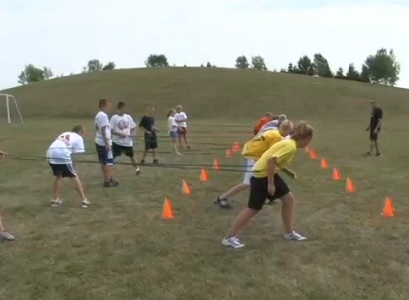Heavier Isn’t Always Better with Shoulder Stabilization Exercises for Athletes
By Pamela MacElree, MS
With certain exercises for athletes, heavier isn’t always better.
EEK! Did I really just write that for everyone to see? Coming from someone who constantly talks about picking up more weight, this might seem like a partial shock to you. The truth of it is that some kettlebell exercises are better served with lighter to moderate weight, especially while learning them.
There are 4 really awesome kettlebell exercises for athletes that will help increase shoulder stabilization. The unique thing about these kettlebell exercises is that we’re working on shoulder stabilization while the body is moving through multiple planes of motion. I’ll go over two now and two in another blog post.
Typically, we could put more weight overhead and stabilize it than we could actually press overhead. In the four kettlebell shoulder stabilization exercises I’m going to go over with you, you will likely find that you need to back off the weight and use something a little lighter than you might initially expect as I mentioned earlier. This is why we choose to do several shoulder stabilization exercises that are more complex than just overhead holds or walks.
Kettlebell Shoulder Stabilization Exercises for Athletes #1: The Arm Bar
Let’s first take a look at the arm bar.
Always start the arm bar by rolling onto your side. Once on your side, grip the handle of the kettlebell with both hands and hold it close to your chest. Next, roll onto your back and press it overhead.

Once you are lying on your back with the kettlebell pressed overhead, raise the opposite side arm overhead on the floor and flex the hip and knee that are on the same side of the body as the kettlebell.

Keep the knee above the hip and begin to rotate to the side that is opposite of the kettlebell. Keep your focus on the kettlebell.

Once you have rotated enough to touch your knee to the ground, begin to straighten that leg and aim to get the front of the hips close to the floor. When you are stable, you can direct your nose toward the floor.

You’ll notice in the arm bar that the shoulder must be very stable as the body moves around the tall pillar that is created by the arm. The kettlebell sits nicely in the hand as the weight sits closer to the shoulder than it would with a dumbbell.
Kettlebell Shoulder Stabilization Exercises for Athletes #2: The High Windmill
The next excellent shoulder stabilization exercise for athletes is the high windmill. Again, the shoulder is forced to stabilize as the body moves. This particular exercise is also great for strengthening the entire core.
Starting with the kettlebell in the overhead position from standing, shift about 70-80% of your bodyweight onto the same side leg that has the kettlebell overhead. Maintain a vertical line with the arm that holds the kettlebell and the same side leg.

While maintaining the weight shift, fold at the hips (similar to the feel of a good morning) and guide your free hand along the inseam of your leg. You can keep a soft bend in the other leg or keep it straight depending on your flexibility.

In these 4 shoulder stabilization kettlebell exercises for athletes (remember, I’ll be sharing 2 more in a second post), the arm always maintains a vertical position to the floor above the shoulder, regardless of where the body is. It is important to keep the shoulder retracted and not elevated, or in layman’s terms, always keep the shoulder down and back. If at any point the arm starts to sway and you are unable to hold the weight of the kettlebell directly over the shoulder, you should decrease the weight you are working with.
Think about the shoulder being the base or foundation and the arm being the structure. The arm must stay vertical and perpendicular to the floor. There should be no bend in the elbow or the wrist as you progress through these kettlebell exercises. Think of it like a leaning building: at some point, the foundation will start to give and the structure will begin to fall.
Check back for the other two kettlebell exercises for athletes on increasing shoulder stabilization.
Can’t wait and want to learn more about kettlebell training?

 After several conversations with the president of the youth football league and some of his coaches, I was able to ascertain the areas they were most concerned with. They were, in their words:
After several conversations with the president of the youth football league and some of his coaches, I was able to ascertain the areas they were most concerned with. They were, in their words: 7. Dynamic Warm Up
7. Dynamic Warm Up –Cool Down–
–Cool Down– Dave Gleason is the owner and head coach of Athletic Revolution in Pembroke, MA. Dave’s career passions are training young athletes 6-18 years old as well as playing an integral role in the development of Athletic Revolution International. Dave was the 2010 IYCA Member of the Year, columnist and presenter. A proud member of the IYCA, Dave is honored to be named to the IYCA Board of Experts.
Dave Gleason is the owner and head coach of Athletic Revolution in Pembroke, MA. Dave’s career passions are training young athletes 6-18 years old as well as playing an integral role in the development of Athletic Revolution International. Dave was the 2010 IYCA Member of the Year, columnist and presenter. A proud member of the IYCA, Dave is honored to be named to the IYCA Board of Experts.







